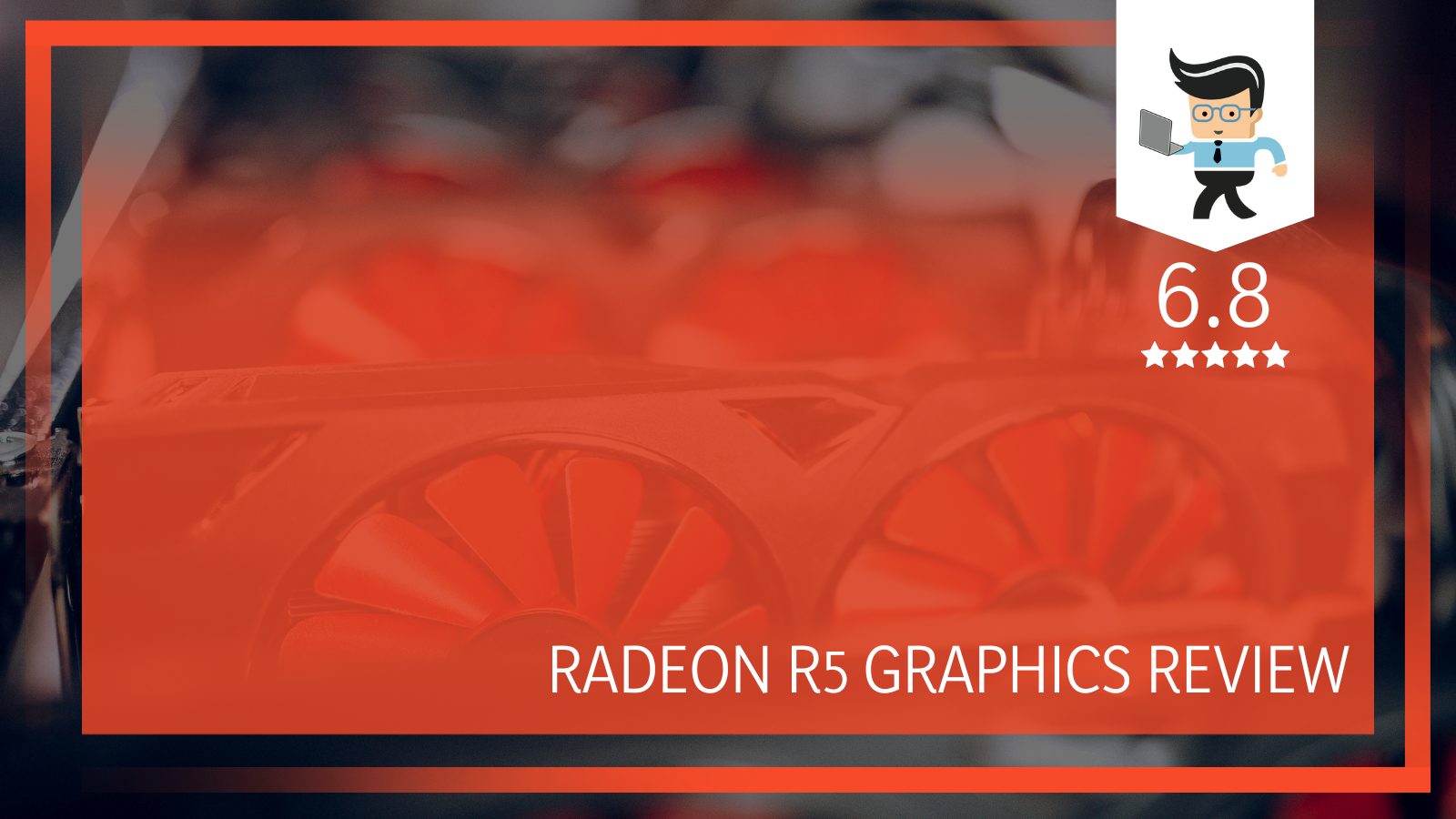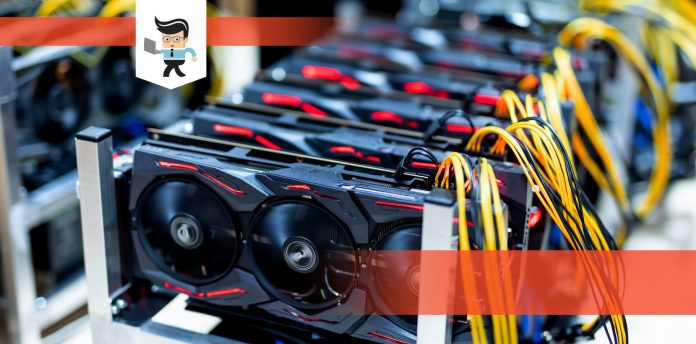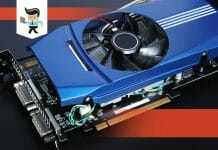AMD Radeon R5 Graphics refers to a class of processors that include graphics processing onboard a CPU as well as separate Radeon GPUs. If you have an older computer that is running either Radeon R5 integrated graphics or an AMD Radeon R5 GPU, you may be wondering what kind of performance you can expect out of your machine.

Unfortunately, the answer to that question is: not much.
Because the integrated graphics share memory with the rest of the system, the video processing has limited capabilities. If you have a separate GPU, it will be better, but the statistics simply cannot compete with modern graphics cards. Read on to find out about the specifications, gaming possibilities, and benchmarks for Radeon
Contents
AMD Radeon R5 Specs
| AMD Radeon R5 Integrated Graphics | AMD Radeon R5 M430 Graphics Card | |
| GPU Clock | 800 MHz | 855 MHz |
| Memory Clock | System Shared | 1746 MHz |
| Memory Size | System Shared | 4 GB |
| Memory Type | System Shared | DDR3 |
| Shading Units | 128 | 320 |
| ROPs | 4 | 8 |
| Float Performance | 204.8 GFLOPS | 547.2 GFLOPS |
AMD Radeon R5 Graphics Review
If you are wondering why there are different specifications for Radeon R5 graphics, you need to understand that there is a difference between integrated graphics and using a dedicate graphics processing unit (GPU). Integrated graphics refers to the graphic processing that is onboard the CPU on the motherboard, whereas a graphics card or GPU is a different piece of technology that is specialized in processing video data for both videogames and video rendering software.
When you are using the integrated graphics, regardless of which manufacturer or central processing unit you choose, you will not have the same performance that you will receive from a dedicated graphics card because it will not have equivalently powerful chips or the same technology designed for processing video code.
AMD is one of two major manufacturers of central processing units and graphics cards, and “R5” is used to refer to both lines of products, containing different items. Read on for a detailed explanation of both R5 integrated graphics and the Radeon R5 graphics card.
Radeon R5 Integrated Graphics
If you are an average computer user and do not utilize higher graphics functions of your machine, then integrated graphics will work well for most video streaming applications you will be using. The integrated graphics are only designed to be used for basic visual processing of word processing applications, streaming videos from Youtube or video streaming sites such as Netflix or Hulu.
The AMD Radeon R5 specs for integrated graphics are unimpressive if you are looking to use them for any sort of higher-end applications, and will only play older games from the early 2010’s which have lower minimum graphics processing requirements. The 800 MHz clock speed is around half of what the clock speeds are for the GTX 1060 and 1070 cards which were the top of the line models a few years ago.
The memory speed is all part of the pool of system memory used by all the applications running the computer and not just the videogame, which means that the available amount of memory for the game is very low, and if it is also trying to run a large or high-resolution monitor in addition to everything else, the visual performance will suffer greatly.
With only 128 shading units compared to shading units in the thousands for higher end models of both Radeon and Intel, the rendering from the Radeon R5 integrated graphics will be fairly low quality as well.
Radeon R5 Graphics Card
Radeon R5 also refers to an AMD Radeon R5 GPU and while they are better than the AMD integrated graphics, they are older cards and their specifications cannot compete with modern graphics cards. The AMD Radeon R5 Performance will exceed the Radeon R5 Integrated Graphics because it has its own memory cache and memory clock, compared to the integrated graphics which will share those specs with the rest of the system.
Because the Radeon R5 M430 has only 320 shader units, the visual experience using the card will not compare to the experience you will get from a higher-end model from either AMD or Intel, even if the card is a few years old. Any of the modern cards will have at least a thousand shader units which will drastically improve the video experience of any application you are running.
The AMD Radeon R5 M430 is the best graphics card from the R5 line, and it is still on the lower end of the spectrum when referring to graphics cards as a market. The “M” in the product name refers to it being “mobile” meaning that it is a graphics card for laptops. It will run the system and visuals necessary for streaming, but it will not deliver high performance gaming.
AMD Radeon R5 Gaming
There are very few games you can play with the AMD Radeon R5 integrated graphics, even when recommendations say that you could still play some pre-2010 games which do not involve a lot of action (i.e., will not play shooters) and limited to 720P at best.
You will be able to play something like Counter Strike: Global Offensive with the AMD Radeon R5, but again you will be limited to 720P if you want the best performance from the game, which will still only be around 30 frames per second on average with all the settings on low to medium.
If you use the AMD Radeon R5 M430, you will have better results than you will with the onboard graphics, just as you would with any graphics card versus the graphics processor on the CPU. You will be able to reach approximately 40 frames per second with the same settings used with the onboard graphics: 720P as the resolution and all the gaming settings themselves set to low or medium.
You will not be able to play Overwatch with either the Radeon R5 integrated graphics or the AMD Radeon R5 GPU because it is simply not powerful enough. Overwatch, while not a technically demanding game (many modern laptops will run it out of the box) has a lot of motion, light, and shadow effects. As a result of Overwatch as obligatory player versus player combat, it requires a certain performance standard that isn’t met by Radeon until the following generation of graphics processing from AMD.
Fortnite is playable, but will be of even lower quality than Counter Strike: Global Offensive. While it is highly recommended that you have the graphics set to 720P for CS:GO, it is mandatory for Fornite, and even then, you will only have framerates in the low 20’s of frames per second. You will need to run an AMD Radeon R5 GPU because it will not work with the Radeon R5 integrated graphics.
In short, if you are looking to play even basic games with your computer, then you should look at getting a better graphics processor than the R5 onboard graphics or the R5 line of AMD GPUs, because they were never designed to support the necessary processing for rendering videogames.
Benchmark and Performance
The user benchmark does not even differentiate the performance scores between the onboard graphics and one of the GPUs for Radeon R5. The AMD Radeon R5 benchmark comes up 97.8% lower than leaders in the graphics processing market. It does note, however, that the AMD Radeon R5 performance spread from the 95th to the 5th percentile is only 0.63% meaning that it is an incredibly consistent card. However, being consistent when you are in the lowest 2% of performance is not a ringing endorsement as to the quality of the graphics processing.
Video Card Benchmark via Passmark gives and AMD Radeon R5 benchmark score of 649. Context is important with numbers like this, because without any additional information or comparisons, 649 doesn’t mean very much. $649 is a lot for a pair of shoes, but $649 is very, very cheap for a car. 649 is a credit score that isn’t terrible, but could also use some improvements.
The R5 graphics received a score of 649 and the GTX 1080 Ti received a score of 14,203. The gaming performance of these graphics will be seriously lacking, so unless you only have a laptop with one of the AMD Radeon GPU’s in it. You should make sure that you use a better machine if you want to have better performance and increase your chances of winning when you play.
Conclusion
AMD Radeon R5 graphics are outdated and outmoded by the ever advancing progression in graphics processing technology. Because the integrated graphics share so much with the rest of the system, they will not be able to keep up with even the dedicated GPUs of their time.
Unfortunately, the AMD Radeon R5 GPU is not much better. They rank consistently low against modern cards, and only have a fraction of the power of newer GPUs. If you have a computer with the Radeon R5 graphics and plan to keep the machine, but want it to provide you with the ability to run graphics processing and you want to play videogames on it, it would be worth at least upgrading to a CPU with better integrated graphics, or upgrading to have a separate GPU.








Thank you for a clear outline.